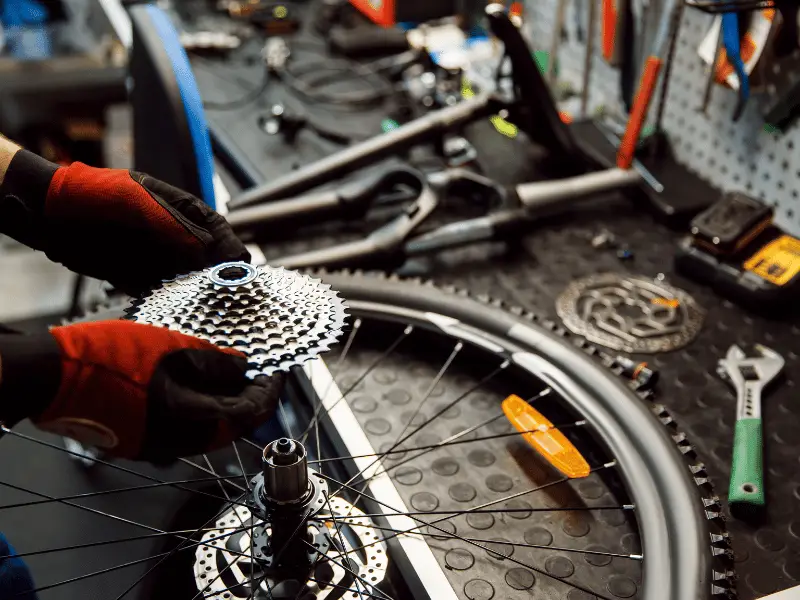
If you’re wondering whether you can use a road cassette on a mountain bike, the answer is yes, but with some caveats. The main difference between a road cassette and a mountain bike cassette is the range of teeth. Road cassettes have closer ratios, which is great for maintaining a consistent cadence on flat terrain, while mountain bike cassettes have wider ranges, making them better for tackling steep climbs and descents.
When it comes to compatibility, Shimano and SRAM road cassettes can be installed on a mountain bike as the splines of the hubs are the same across the MTB and road models of both brands. However, a Campagnolo road cassette will not fit on an MTB hub. It’s important to note that if you want to use a road cassette on an MTB freehub, you’ll need to add a 1.85mm spacer on its inner side.
The benefits of installing a road cassette on an MTB include smaller gear jumps, which can be helpful for maintaining a steady cadence on flat terrain. However, keep in mind that road cassettes may not have low enough gears for steep climbs, so you may need to upgrade your cassette to a mountain bike cassette with a wider range of teeth.
Overall, whether you can use a road cassette on a mountain bike depends on your riding style, terrain, and preferences.
What to Consider Before Using a Road Cassette on a Mountain Bike
When it comes to upgrading or replacing your mountain bike cassette, you may be wondering whether you can use a road cassette on your mountain bike. While it is possible, there are some important factors to consider before making the switch.
Compatibility
First and foremost, you need to ensure that the road cassette you choose is compatible with your mountain bike’s drivetrain system. This includes the number of speeds, the spacing between the cogs, and the spline pattern on the freehub body. For example, a Shimano 11-speed road cassette may not be compatible with a 9-speed mountain bike drivetrain.
Gear Ratios
Another important factor to consider is the gear ratios of the road cassette compared to your mountain bike cassette. Road cassettes typically have closer gear ratios, which may not be ideal for mountain biking, especially when climbing steep terrain. You may need to swap out your chainrings or adjust your derailleur to accommodate the changes in gear ratios.
Terrain and Riding Style
The type of terrain you ride and your riding style also play a role in whether a road cassette is suitable for your mountain bike. If you primarily ride on flat or rolling terrain, a road cassette may work well for you. However, if you frequently encounter steep climbs or technical descents, a mountain bike cassette with wider gear ratios may be more appropriate.
When considering whether to use a road cassette on your mountain bike, it’s important to weigh the potential benefits and drawbacks. While a road cassette may offer smoother shifting and lower weight, it may not provide the necessary gear options for your riding needs. Ultimately, the decision depends on your individual preferences and riding style.
In summary, before using a road cassette on your mountain bike, you should consider compatibility, gear ratios, terrain, and riding style. By taking these factors into account, you can make an informed decision about whether a road cassette is right for you.
How to Use a Road Cassette on a Mountain Bike
If you have a mountain bike and want to use a road cassette, it is possible. Here are the steps to follow:
Removing the Old Mountain Bike Cassette
- Remove the rear wheel from the bike.
- Use a chain whip to hold the cassette in place while using a cassette lockring tool to unscrew the lockring.
- Remove the old cassette from the freehub body.
Installing the Road Cassette
- Check that the new road cassette has the same number of gears as the old mountain bike cassette.
- If the road cassette has fewer gears, you will need to add a spacer to the freehub body before installing the cassette.
- Slide the road cassette onto the freehub body.
- Use the cassette lockring tool to tighten the lockring.
Adjusting the Derailleur
- Shift the bike into the smallest cog on the cassette and the largest chainring on the front.
- Adjust the high-limit screw on the rear derailleur to align the jockey wheel with the smallest cog.
- Shift the bike into the largest cog on the cassette and the smallest chainring on the front.
- Adjust the low limit screw on the rear derailleur to align the jockey wheel with the largest cog.
- Shift through all the gears to ensure smooth shifting.
- If necessary, adjust the cable tension using the barrel adjuster on the rear derailleur until the shifting is smooth and precise.
By following these steps, you can successfully use a road cassette on your mountain bike. However, keep in mind that road cassettes have higher gearing and smaller jumps between each gear, so you may need to adjust your riding style accordingly.
